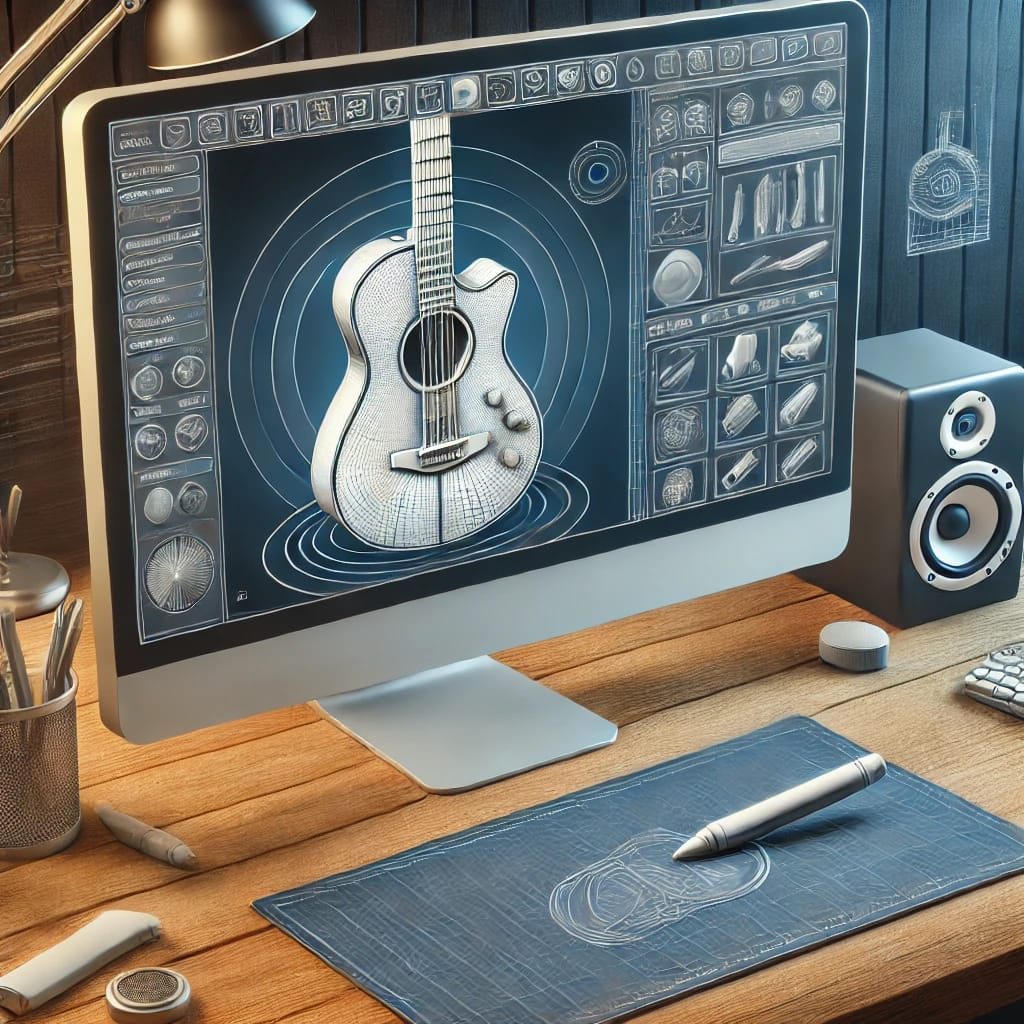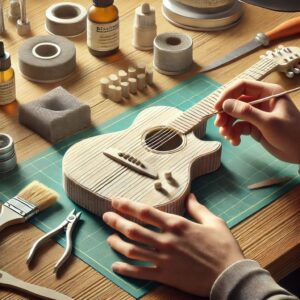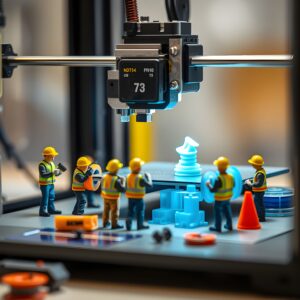Innovative 3D Printed Musical Instruments: Pushing the Boundaries of Sound

Explore how 3D printing technology is revolutionizing the world of musical instruments. From precision design to new soundscapes, discover the latest innovations pushing the boundaries of music.
A New Era in Instrument Design
Music has always been deeply intertwined with technology, evolving through centuries as new tools and materials shaped the way we create and experience sound. From the invention of the piano to the introduction of electronic synthesizers, the development of instruments has consistently pushed the boundaries of what is musically possible. Today, we are witnessing another groundbreaking shift: the use of 3D printing technology in crafting musical instruments.
3D printing, also known as additive manufacturing, involves creating three-dimensional objects layer by layer using computer-based designs. Its entrance into the music world has brought forth a wave of innovation, allowing for unprecedented creativity in instrument design, customization, and functionality. What was once considered impossible—producing intricate sound-producing structures with high precision—is now achievable with this cutting-edge technology.
The idea of 3D-printed musical instruments is more than just a novel concept. It’s a transformative movement that combines engineering, artistry, and accessibility. With 3D printing, musicians and designers can create instruments that are lightweight, customizable, and capable of producing unique sounds that traditional fabrication methods could never achieve. Whether you’re a professional musician or an amateur enthusiast, these instruments open up new possibilities for self-expression.
Moreover, 3D-printed instruments challenge long-established norms around craftsmanship and affordability in the music industry. Traditional instruments often take weeks to build, require expensive materials, and are designed for mass production. By contrast, 3D printing enables rapid prototyping and the creation of bespoke products tailored to an individual’s vision. This democratization of instrument design removes barriers and puts creative power directly into the hands of musicians themselves.
This article will explore the fascinating world of 3D-printed musical instruments. From versatile design capabilities to the benefits of customization and the unique soundscapes they produce, we’ll dive into how this technology is reshaping the realm of music. We’ll also examine the challenges, case studies, and the potential future of 3D-printed instruments, offering a glimpse into how this innovation is changing how we play, learn, and create music.
How 3D Printing is Revolutionizing Instrument Design
The core advantage of 3D printing lies in its ability to fabricate complex designs that would be difficult, if not impossible, to achieve with traditional manufacturing techniques. This has proven to be especially useful for musical instruments, where precision in design and tonal accuracy are essential. These instruments are no longer bound by the limitations of conventional materials or handcrafting constraints. Instead, they embrace customization and experimentation, opening the doors to endless possibilities.
One of the most remarkable features of 3D printing is its capacity for customization . Musicians can design instruments that reflect their unique style or ergonomic preferences. For example, a guitarist with a particular hand shape can request a custom-fitted guitar neck designed specifically to optimize comfort and playability. Similarly, wind instrument players can create mouthpieces and tuning modifications tailored to their needs. This level of modification allows musicians to achieve greater precision and control over their sound.
Beyond customization, 3D-printed instruments allow for creative exploration in shape and structure. Traditional instruments like violins, pianos, or trumpets are often limited to specific, time-honored designs. However, with 3D printing, these constraints disappear. Designers have created violins with futuristic shapes, saxophones with intricate internal chambers, and even flutes capable of producing sounds across broader frequency ranges, thanks to unconventional bore designs.
Another groundbreaking innovation is the ability to integrate unconventional materials. Unlike traditional instruments that rely on wood, brass, or specific metals, 3D-printed instruments can incorporate materials like polymers , nylon composites , or even biodegradable plastics while maintaining high acoustic quality. These materials add structural integrity while reducing production costs and allowing for eco-friendly solutions, which appeal to environmentally conscious creators.
Lastly, 3D printing has introduced the concept of modularity , allowing musicians to experiment with interchangeable components. For instance, a 3D-printed clarinet can include swappable mouthpieces and barrels, enabling musicians to alter tone or pitch depending on the needs of a particular performance. This modular approach enhances flexibility and empowers artists to create entirely new soundscapes. It’s clear that 3D printing is redefining how musical instruments are conceived and constructed.
Notable Innovations in 3D-Printed Instruments
The 3D printing revolution has inspired incredible ingenuity among engineers, product designers, and musicians eager to experiment with its potential. Some of the instruments being developed today challenge long-held perceptions of form and function, proving that 3D-printed instruments are more than just experimental projects—they represent a meaningful evolution in instrument design.
One famous example is the 3D-printed violin by Hovalin , which mirrors the structure and functionality of traditional violins but at a fraction of the cost. Priced at just a few hundred dollars and constructed of PLA (a biodegradable thermoplastic), this instrument is a testament to how 3D printing can make high-quality instruments affordable and accessible to a broader audience. It retains tonal accuracy and is often praised for its ease of assembly.
Another remarkable innovation is the 3Dvarius , the world’s first fully 3D-printed electric violin. Created by French engineer and musician Laurent Bernadac, the 3Dvarius is inspired by the iconic shape of a Stradivarius violin but adopts a minimalist, lightweight design that enhances sound clarity. Its transparent body and futuristic aesthetic highlight how 3D printing can blend artistry with advanced acoustic engineering.
Wind instruments have also benefited greatly from 3D printing. A notable creation is the 3D-printed saxophone invented by Olaf Diegel, an industrial designer. Diegel’s saxophone weighs significantly less than a traditional saxophone, allowing for greater portability, while still producing a warm, authentic sound. Its intricate construction features elaborate internal chambers optimized for airflow—something that would be nearly impossible to achieve with conventional manufacturing.
In the realm of percussion, 3D printing has allowed for the production of experimental drums, such as those with unique shell shapes to amplify sound differently. Composite materials like nylon and carbon fiber are used to craft lighter yet resonant drum designs. Some of these percussion instruments also include modular shells, allowing drummers to experiment with different tonal combinations effortlessly.
Perhaps the most futuristic innovation lies in printable hybrid instruments. These combine traditional instrument functions with integrated electronic components, such as MIDI interfaces or sensors. For instance, 3D-printed guitars with embedded sensors can connect directly to digital audio workstations (DAWs) for seamless sound experimentation. Through such designs, we are beginning to bridge the gap between acoustic tradition and digital innovation.
Advantages of 3D Printing in Music
The popularity of 3D-printed musical instruments is deeply rooted in the benefits they offer over traditional manufacturing methods. Musicians, designers, and consumers alike gain access to a host of opportunities that elevate performance, accessibility, and sustainability.
One of the most significant benefits is cost-effectiveness. Traditional instruments, particularly high-quality ones, are expensive due to the labor, materials, and time required for construction. With 3D printing, creating functional and professional-grade instruments becomes significantly more affordable, enabling access for musicians who previously couldn’t afford premium instruments. This democratization of music tools has the potential to foster talent across a wide range of socioeconomic backgrounds.
Another major advantage is speed. Traditional craftsmanship can take weeks, months, or even years to produce an instrument, while a 3D printer can create an intricate, high-quality object in days or hours. This ability to “print on demand” is especially beneficial for prototyping. Designers can test multiple iterations of a single instrument, optimizing its acoustics, durability, and aesthetics with unparalleled efficiency.
From an environmental perspective , 3D printing presents a sustainable alternative. Traditional music manufacturing often involves the use of rare woods, metals, and other non-renewable materials. In contrast, 3D printers can utilize recyclable and biodegradable materials such as PLA filament, reducing the environmental impact of instrument production. This appeals to environmentally conscious musicians and aligns with global sustainability goals.
Accessibility is another undeniable benefit. Aspiring musicians, students, and educators often find themselves limited by budget constraints when purchasing instruments. 3D printing resolves this issue by offering affordable options that maintain functionality and acoustic quality. Printable designs can even be freely downloaded from open-source platforms, enabling access like never before.
Finally, the customization and modularity of instruments create immense value for professional musicians. No longer are players confined to standardized instrument designs. They can adapt instruments to their individual physicality and preferences, enhancing their ability to perform expressively. Additionally, modular instruments allow experimentation with interchangeable parts, unlocking a playground of creative possibilities.
Challenges and Limitations of 3D-Printed Instruments
Despite their many advantages, 3D-printed musical instruments face several challenges that cannot be overlooked. While the technology is innovative, it is still maturing, and widespread adoption in the professional music industry remains an uphill journey.
The first challenge lies in acoustic quality. While 3D printing provides exceptional structural flexibility, it isn’t always able to replicate the nuanced tonal qualities of traditional materials like wood or brass. For example, violins made from synthetic polymers often lack the rich resonance produced by their wooden counterparts. Similarly, plastic saxophones may sound authentic to the casual listener but lack the depth and warmth valued by professionals.
Durability is another area of concern. While modern printers allow the use of materials like carbon fiber composites to improve strength, many printed instruments remain fragile compared to traditional ones. This limitation is particularly problematic for instruments subjected to frequent handling or exposure to environmental factors like humidity or extreme temperatures.
The skill gap in creating 3D-printed instruments is another significant hurdle. While 3D printing has become more accessible in recent years, designing functional instruments still requires extensive knowledge of computer-aided design (CAD), acoustics, and music theory. Musicians without technical expertise may struggle to fully utilize the customization possibilities without external help.
Additionally, 3D printers capable of producing high-quality, finely detailed instruments are still expensive and out of reach for many. While open-source designs are available online, musicians often need the resources of a professional-grade printer to achieve satisfactory results. This reliance on advanced equipment can act as a barrier for widespread domestic use.
Finally, there is a question of mainstream acceptance. Many traditionalists in the music community view 3D-printed instruments as novelties rather than serious, professional-grade tools. Convincing purists to embrace this technology will require further advancements in sound quality, durability, and aesthetics—all areas where traditional craftsmanship currently holds an edge.
The Future of 3D-Printed Musical Instruments
As 3D printing technology evolves, the future of musical instruments looks increasingly innovative and collaborative. Widespread adoption may not come overnight, but the groundwork is being laid for a future where 3D-printed instruments play a major role in education, performance, and even orchestral settings.
One promising avenue is hybrid instrument design. We are already seeing prototypes of violins and guitars with built-in MIDI interfaces, enabling seamless interplay between analog and digital music production. These hybrids appeal to modern musicians who straddle the line between traditional performance and electronic composition. Continued innovation in this area may establish 3D printing as a key tool in crafting instruments for the next generation of artists.
The education sector is another area ripe for disruption. Schools and music programs with limited budgets can benefit enormously from 3D-printed instrum
ents, which are far more affordable than traditional ones. Imagine students learning the fundamentals of guitar or flute on printed instruments before transitioning to higher-end models once they build proficiency. This accessibility could nurture a new wave of talent.
Advanced materials such as conductive polymers, graphene composites, and revolutionary inks are being explored for integration into 3D-printed instruments, which could provide superior acoustic properties and enhanced durability. These materials may even facilitate entirely new types of instruments that weren’t technically feasible before.
Collaborative design platforms are expected to thrive as well. Musicians, engineers, and hobbyists can work together globally to create open-source instrument designs that anyone can print. This democratization of design puts the power of innovation in the hands of every creator, fostering a culture of shared discovery and mutual inspiration.
In the long term, 3D-printed instruments may become widely accepted alongside traditional instruments in professional and amateur music settings alike. As technology advances, the boundaries between old-world craftsmanship and new-world
innovation will blur, creating instruments that are as aesthetically stunning as they are musically unparalleled.
Redefining the Sound of Music
The rise of 3D-printed musical instruments marks a significant turning point in the world of music. By combining technology, creativity, and accessibility, 3D print
ing has empowered musicians to explore uncharted soundscapes, customize their instruments, and experiment with modular configurations. While challenges such as acoustic quality and durability persist, ongoing advancements in material science and design sophistication promise to address these limitations.
As the music world evolves, 3D-printed instruments will likely play a pivotal role not just in performance but also in education, collaboration, and sustainability. Whether it’s an intricately designed guitar, a futuristic violin, or a saxophone optimized for portability, the era of 3D-printed instruments represents infinite possibilities for those willing to embrace innovation.
Ultimately, the adoption of 3D printing in music isn’t about replacing tradition—it’s about expanding it. By pushing the boundaries of sound and design, creators, musicians, and engineers are opening the door to entirely new forms of expression. The question is no longer just “What is possible?” but rather, “What’s next?” This harmonious union of technology and artistry will continue to inspire generations of musicians to come.
Check out our next article on How to Design and Print Your Own 3D Printed Musical Instrument https://master3dp.com/how-to-design-an…sical-instrument/
For other insights and projects, be sure to explore our Key Technologies in 3D Printing or Uses of 3D Printing column




